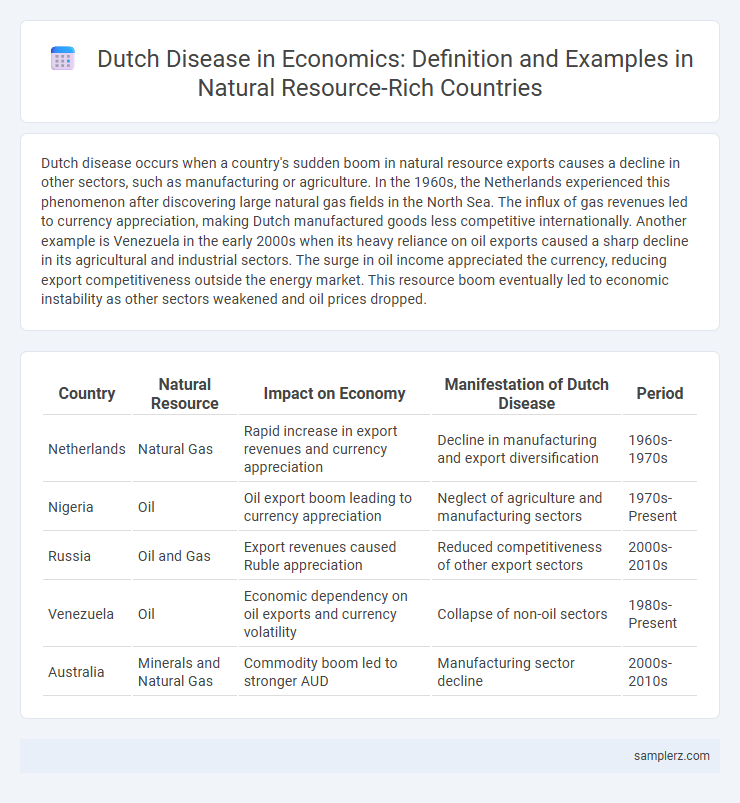Dutch disease occurs when a country's sudden boom in natural resource exports causes a decline in other sectors, such as manufacturing or agriculture. In the 1960s, the Netherlands experienced this phenomenon after discovering large natural gas fields in the North Sea. The influx of gas revenues led to currency appreciation, making Dutch manufactured goods less competitive internationally. Another example is Venezuela in the early 2000s when its heavy reliance on oil exports caused a sharp decline in its agricultural and industrial sectors. The surge in oil income appreciated the currency, reducing export competitiveness outside the energy market. This resource boom eventually led to economic instability as other sectors weakened and oil prices dropped.
Table of Comparison
| Country | Natural Resource | Impact on Economy | Manifestation of Dutch Disease | Period |
|---|---|---|---|---|
| Netherlands | Natural Gas | Rapid increase in export revenues and currency appreciation | Decline in manufacturing and export diversification | 1960s-1970s |
| Nigeria | Oil | Oil export boom leading to currency appreciation | Neglect of agriculture and manufacturing sectors | 1970s-Present |
| Russia | Oil and Gas | Export revenues caused Ruble appreciation | Reduced competitiveness of other export sectors | 2000s-2010s |
| Venezuela | Oil | Economic dependency on oil exports and currency volatility | Collapse of non-oil sectors | 1980s-Present |
| Australia | Minerals and Natural Gas | Commodity boom led to stronger AUD | Manufacturing sector decline | 2000s-2010s |
Overview of Dutch Disease in Natural Resource Economies
Dutch Disease often manifests in natural resource economies when large resource exports lead to currency appreciation, reducing the competitiveness of the manufacturing sector. Countries like Nigeria and Venezuela illustrate this phenomenon, where oil booms caused a decline in industrial output and economic diversification. This shift results in increased vulnerability to commodity price fluctuations and long-term economic instability.
Classic Case: The Netherlands and North Sea Gas
The classic case of Dutch disease occurred in the 1960s when the Netherlands discovered vast North Sea gas reserves, leading to a sharp increase in natural gas exports and government revenues. This boom caused appreciation of the Dutch guilder, making non-energy sectors like manufacturing and agriculture less competitive internationally. Consequently, the economy experienced deindustrialization while becoming increasingly reliant on volatile resource rents from the gas sector.
Nigeria’s Oil Boom and Economic Challenges
Nigeria's oil boom in the 1970s led to a classic case of Dutch disease, where the inflow of oil revenues caused currency appreciation, making non-oil sectors like agriculture and manufacturing less competitive. The overreliance on oil exports resulted in economic volatility and underinvestment in diversified industries, exacerbating vulnerability to oil price shocks. Persistent exchange rate misalignment and fiscal dependence on oil revenues have hindered sustainable economic growth and development in Nigeria.
Venezuela’s Oil Wealth and Industrial Decline
Venezuela's oil wealth led to a classic case of Dutch disease, where booming oil exports caused a sharp appreciation of the currency, making non-oil sectors less competitive internationally. The oil revenue influx resulted in neglect of manufacturing and agriculture, causing industrial decline and increased economic dependence on oil. This resource-driven economic imbalance exposed Venezuela to volatile oil prices, triggering severe recession and long-term structural challenges.
Russia’s Natural Gas Exports and Sectoral Imbalances
Russia's economy illustrates Dutch disease through its heavy reliance on natural gas exports, which has led to significant sectoral imbalances. The inflow of revenues from natural gas has caused currency appreciation, making manufacturing and agriculture less competitive internationally. This dependency on the energy sector has constrained economic diversification and increased vulnerability to global energy price fluctuations.
The Impact of Diamonds on Botswana’s Broader Economy
The discovery of diamonds in Botswana transformed its economy by significantly increasing export revenues and government income, leading to rapid infrastructure development and improved social services. However, the influx of diamond wealth caused currency appreciation, making non-mining sectors like agriculture and manufacturing less competitive internationally, a classic manifestation of Dutch disease. Despite these challenges, Botswana managed to mitigate adverse effects through prudent fiscal policies and investment in diversification efforts.
Australia’s Mining Boom: Balancing Growth and Sector Risks
Australia's mining boom, fueled by rich natural resources like iron ore and coal, exemplifies Dutch disease by driving currency appreciation that challenged competitiveness in other sectors such as manufacturing and agriculture. The surge in export revenues caused the Australian dollar to strengthen, making non-mining exports less competitive globally and highlighting the delicate balance between resource-driven growth and economic diversification. Policymakers focused on investing mining profits into infrastructure and innovation to mitigate long-term risks and sustain broader economic stability.
Norway’s Oil Revenue Management and Avoiding Dutch Disease
Norway's strategic management of oil revenues through the Government Pension Fund Global has effectively mitigated Dutch disease by preventing excessive currency appreciation and maintaining economic stability. The fund invests oil income abroad, supporting fiscal discipline and diverse domestic sectors such as manufacturing and services. This approach preserves competitiveness and long-term economic resilience despite large natural resource wealth.
Saudi Arabia’s Oil Dependency and Economic Diversification
Saudi Arabia's economy exemplifies Dutch disease, where heavy reliance on oil exports has led to currency appreciation and a decline in non-oil sectors. This oil dependency caused a resource curse, hampering manufacturing and agriculture while government revenues fluctuate with global oil prices. The kingdom's Vision 2030 initiative targets economic diversification by investing in renewable energy, tourism, and technology to reduce vulnerability to oil market volatility.
Indonesia’s Resource Exports and Manufacturing Sector Transformation
Indonesia's experience with Dutch disease highlights the challenges of reliance on natural resource exports like palm oil and coal, which have caused currency appreciation and made manufacturing less competitive. This economic phenomenon led to a contraction in Indonesia's manufacturing sector, particularly in textiles and electronics, undermining export diversification efforts. Policymakers are now focused on balancing resource revenues with investments in technology and infrastructure to promote sustainable industrial growth and economic resilience.

example of Dutch disease in natural resource Infographic
 samplerz.com
samplerz.com